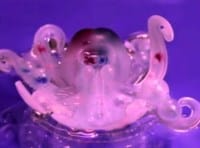
CREEPY CRAWLIES CLEAN THE HOUSE AND POOL

Combining biotech with 3D printing and robotics creates quantum leap
- Dateline
- 7 December 2019
Another breakthrough has been revealed, this time in the arcane science of biobotics; not bionic appliances for humans, but organic robots. These are machines built with ceramics, metals and living tissue – usually cells cultured from lab rats.
Biobots are not really living machines like radio controlled cockroaches or zombie moths. Rather they are a combination of biological material like muscle and synthetics like silicon, controlled by electronics, enzymes and light pulses.
In 2016, scientists from Harvard and Stanford created miniature stingrays made from gold and rat muscle, that could be steered with light pulses. This was the start of a whole new branch of advanced robotics and biological engineering.
Now we have all sorts of creepy crawlies that are made with 3D printers, integrating muscle and sensory tissue with artificial skeletons and shells, and controlled by microchips. They roam around the house, cleaning surfaces and eating dead bugs. Some swim in the pool, keeping it clean and sparkling.
Soon there will be robots in our factories and warehouses that are part animal, part machine; other machines use biobotics for such mundane tasks as water purification and chemical processes.
There are many applications where biobots are superior to ordinary machines. Living tissue is self-repairing, if handled properly, and lasts longer. Sometimes nature just does the job more efficiently, so why not use it?
Links to related stories
- These Tiny Cyborg Stingrays Are Made Out of Rat Parts - Wired, 5 December 2016
- The first autonomous, entirely soft robot - EurekAlert, 24 August 2016
- TINY, SOFT ROBOTIC CATERPILLAR CREEPS, CLIMBS, AND CRAWLS - Popular Science, 18 August 2016
- MindBullet: LIVING MACHINES TO CHANGE OUR WORLD FUNDAMENTALLY (Dateline: 27 October 2019, Published: 19 December 2013)
- MindBullet: NETWORKED ROBOTS ALL OVER MY HOUSE & GARDEN (Dateline: 12 November 2015, Published: 03 November 2005)
Warning: Hazardous thinking at work
Despite appearances to the contrary, Futureworld cannot and does not predict the future. Our Mindbullets scenarios are fictitious and designed purely to explore possible futures, challenge and stimulate strategic thinking. Use these at your own risk. Any reference to actual people, entities or events is entirely allegorical. Copyright Futureworld International Limited. Reproduction or distribution permitted only with recognition of Copyright and the inclusion of this disclaimer.